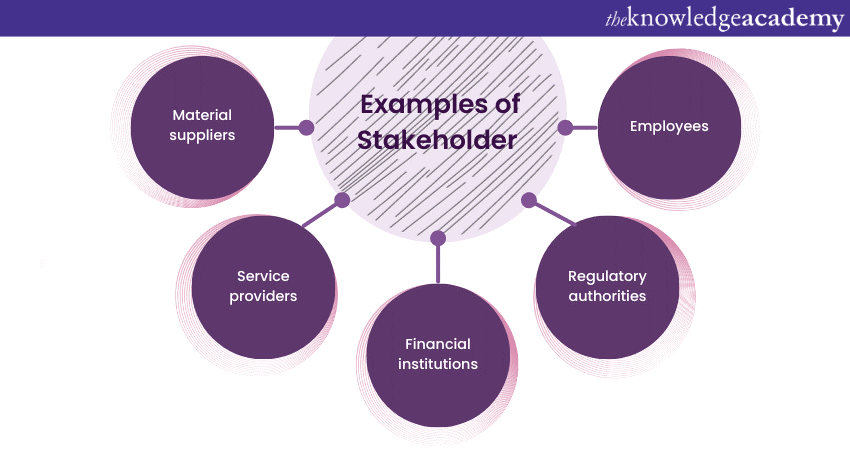We may not have the course you’re looking for. If you enquire or give us a call on 01344203999 and speak to our training experts, we may still be able to help with your training requirements.
Training Outcomes Within Your Budget!
We ensure quality, budget-alignment, and timely delivery by our expert instructors.

What is a Stakeholder? Have you ever wondered about the essential people in a project? In simple terms, a Stakeholder is anyone who has an interest or concern in a project's outcome. They can greatly influence its success or failure.
In this blog, we will learn about What is a Stakeholder, different types, importance, examples and more. Read further to get a better understanding!
Table of Contents
1) Meaning of a Stakeholder
2) Different types of Stakeholders
3) Distinguishing between Stakeholders and Shareholders
4) Examples of a Stakeholder
5) How to manage Stakeholders?
6) Conclusion
Meaning of a Stakeholder
A Stakeholder is someone, a group, or a company affected by the results of a project or a business endeavour. These individuals or entities care about whether the project succeeds and can be from the organisation running the project or outside it. Stakeholders matter because their choices can either help or hinder the project. Some are particularly vital, and the project can't proceed without their support; we call them critical or key Stakeholders.
Different Types of Stakeholders
Stakeholders can be those who have the power to influence the project or those who can be influenced by it. Stakeholders can be categorised into two main groups: Internal Stakeholders and external Stakeholders. Let's examine both of these categories.
1) Internal Stakeholders
Internal Stakeholders are people inside the organisation who are directly affected by the project because they work for or are connected to the organisation overseeing it. These can be employees, owners, the board of directors, project managers, investors, and others.
2) External Stakeholders
External Stakeholders are individuals or groups who are not part of the organisation but still feel the effects of the project. They're not employees, but they can include suppliers, customers, people the organisation owes money to, clients, middlemen, rivals, the general public, government, and others.
Distinguishing Between Stakeholders and Shareholders
Shareholders are a subset of Stakeholders with a financial stake in a company. While Stakeholders have a general interest in a company's performance, shareholders specifically focus on how well the company's stocks perform and the returns on their investments.
When a shareholder invests in a company, their money supports the organisation and its operations. Depending on the extent of their investment, shareholders may have a more significant impact on the organisation and its projects compared to other Stakeholders. Shareholders' investments may also grant them the privilege of receiving regular financial updates about the company and the opportunity to participate in business decision-making.
Unlock your potential as a Business Analyst and master the art of Stakeholder engagement with our Creating Effective Stakeholder Engagement Training - join today!
Importance of Stakeholders
The significance of Stakeholders in the context of a business is underscored by several key reasons. These reasons are discussed below:
a) Support and resources: Stakeholders, particularly investors and financiers, provide crucial financial support, resources, and funding necessary for the initiation and sustenance of projects or business operations.
b) Influence and decision-making: Stakeholders often possess the authority to influence decision-making processes. They may participate in strategic planning, governance, and policy formulation, shaping the direction of the project or business.
c) Accountability and transparency: Stakeholders, including regulatory bodies and the public, demand accountability and transparency. This fosters ethical practices and responsible governance, enhancing the credibility of the business.
d) Risk mitigation: By involving various Stakeholders, businesses can identify and mitigate risks more effectively. Different perspectives and insights can lead to better risk management strategies.
e) Customer satisfaction: Satisfied customers are vital Stakeholders. Their feedback and loyalty impact a business's success. Happy customers can become brand advocates, leading to increased sales and brand reputation.
f) Employee engagement: Employees are integral Stakeholders. Their commitment and motivation are essential for productivity and innovation. Engaging employees can lead to higher job satisfaction and better performance.
g) Community and social responsibility: Businesses often operate within a community and have a social responsibility. Engaging with local communities and addressing social issues can improve public perception and goodwill.
h) Adaptation to change: Stakeholder input helps businesses adapt to changing market conditions and emerging trends. This agility is critical for staying competitive and relevant.
Unlock the power of data with our Introduction To Business Analytics Training and make informed decisions for a brighter business future!
Examples of a Stakeholder
Listed below are a few examples of Stakeholders:

a) Material suppliers: Companies or individuals providing raw materials or components essential for the manufacturing process.
b) Service providers: Entities offering specialised services like transportation, logistics, or maintenance critical to the production and supply chain.
c) Financial institutions: Banks or lenders providing financing options, loans, or credit lines for the company's operations.
d) Regulatory authorities: Government bodies responsible for overseeing industry standards and compliance with regulations related to the manufacturing sector.
e) Employees: Workers within the manufacturing company who rely on a stable supply chain for job security and livelihood.
How to Manage Stakeholders?
Managing Stakeholders effectively is crucial for the success of any project or business. The process involves understanding their interests, expectations, and influence, and then developing strategies to engage, communicate, and collaborate with them. This can be achieved through several key steps, including
a) Identifying Stakeholders
b) Categorising Stakeholders
c) Establishing clear lines of communication
d) Regularly updating them on project progress
It's also essential to address their concerns and feedback, involve them in decision-making where appropriate, and ensure transparency and accountability in all interactions. A well-executed Stakeholder management plan not only helps in building strong relationships but also mitigates risks, enhances support, and fosters a positive reputation, ultimately contributing to the achievement of project goals and long-term success.
Conclusion
Understanding "What is a Stakeholder?" is a fundamental aspect of Project Management and business strategy. Stakeholders can be internal, such as employees, or external, including customers, suppliers, regulatory bodies, and the broader community. Recognising the multifaceted nature of Stakeholders and their distinct roles is essential for effective management and fostering positive relationships.
Unlock your potential as a business analyst – Join now for our courses on Business Analyst Training and transform data into strategic insights!
Frequently Asked Questions
Upcoming IT Service Management Resources Batches & Dates
Date
 Creating Effective Stakeholder Engagement Training
Creating Effective Stakeholder Engagement Training
Fri 23rd Aug 2024
Fri 6th Dec 2024
Fri 7th Feb 2025
Fri 2nd May 2025
Fri 5th Sep 2025
Fri 5th Dec 2025







 Top Rated Course
Top Rated Course



 If you wish to make any changes to your course, please
If you wish to make any changes to your course, please


